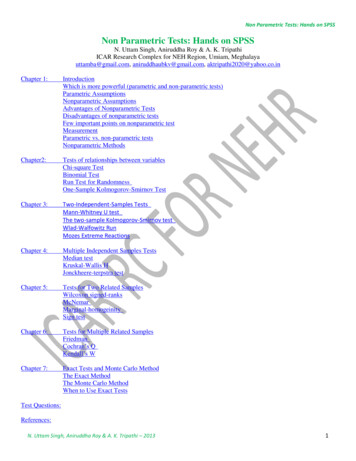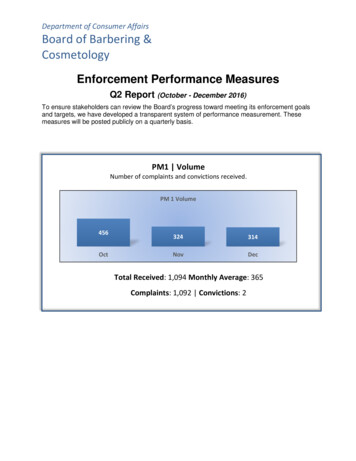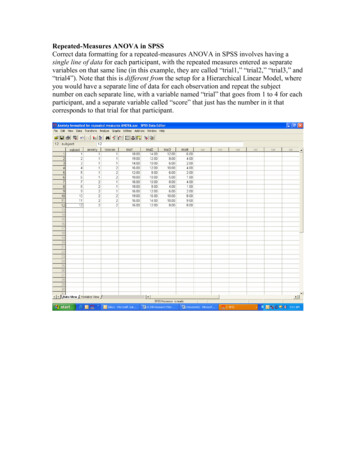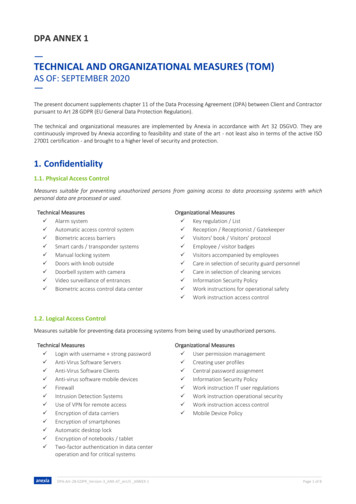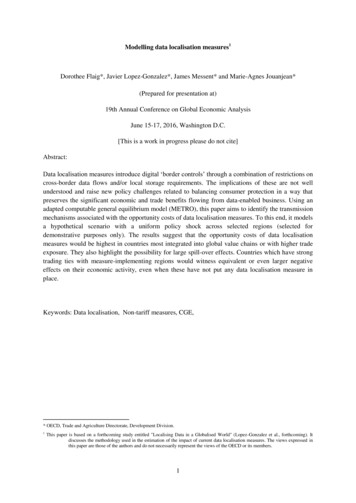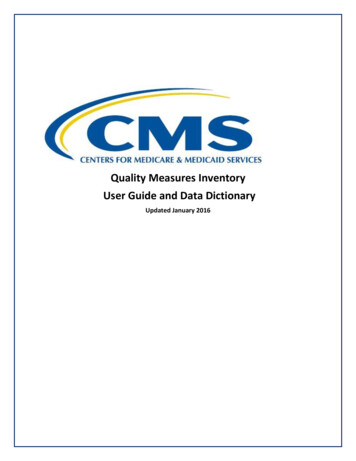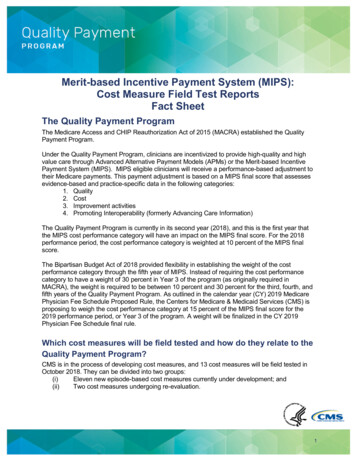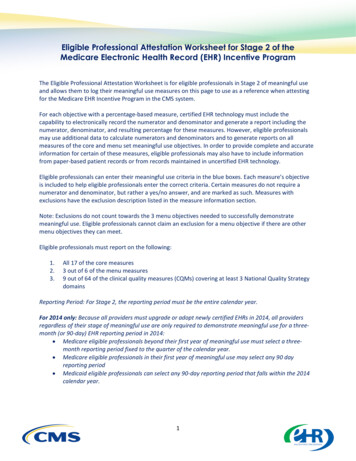
Transcription
4PERFORMANCE MEASURESObjectiveStrategic, performance measurement-based management systems allow an organization to align its business activitities toits strategy, and to monitor performance toward strategic goalsover time.DefinitionsPerformance Measures should identify the population tobe measured, the method of the measurement, and thedata source and time period for the measurement. Eachmeasure should also be: objective easy to understand controllable by minimizing outside influences timely accurate cost-effective usefulHow does an enterprise (agency, business) know how well it’s doing? As thevagaries of the stock market haveshown us, there is more to a company’s performance than just its financials. High-performing enterprisesactively identify “key performanceindicators,” and measure theirprogress against established targetvalues for those indicators, as a wayof measuring their effectiveness. Thisis performance management, and thekey indicators are the PerformanceMeasures (or metrics) of the enterprise. motivating trackablePerformance Measures are quantitative or qualitativeways to characterize and define performance. They provide a tool for organizations to manage progress towardsachieving predetermined goals, defining key indicators oforganizational performance and Customer satisfaction.Performance Measurement is the process of assessingthe progress made (actual) towards achieving the predetermined performance goals (baseline). Measurement ismanaged using output measures and outcome measures.Output measures are calculations of recorded activityor effort expressed quantitatively or qualitatively.Outcome measures are an assessment of the resultsof a program compared to its intended purpose.Performance management is used totrack an organization’s progressagainst its strategic plan and specificperformance goals. While Performance Measures may be applied toindividual projects to ensure thatdeadlines are met and costs are controlled, etc., it is essential for theProject Manager to understand howthe project itself supports the organization’s strategy, and how the projectwill impact or influence the organization’s key Performance Measures.This chapter identifies key performance measurement terms and concepts to orient the Project Manager tothis important aspect of organizational performance.51
52Section II:4 Performance MeasuresNYS Project Management GuidebookPurposeThe concept of Performance Measures may be new to manyPerforming Organizations. If Performance Measures do notexist in an organization, a Project Manager may want to develop a system to prove the effectiveness of his own project. In sodoing, the Project Manager might also contribute to processimprovements within the organization.Project Managers should consider the following to ensure thatprojects align with the Performing Organization’s mission andstrategy: Does the agency have a mission and strategic plan? Is it clearly articulated? Does the organization understand how its activitiescontribute to mission success? Does understanding of the mission extend verticallythroughout the organization? Are the measures of success focused (at least in part) onoutcomes? Are the measures related to the mission and goals asreflected in the strategic plan? Are the performance data reliable? Are appropriate measures reported to individuals atdifferent levels of the organization, and to externalstakeholders? Are Performance Measures used to influence and/or informresource allocation decisions? Is there any relationship between organizational performance and individual or group incentives to contribute toorganizational performance?In some organizations, projects are selected because they willenhance operational performance. For example, a project maybe intended to reduce cycle time, improve time to market, orincrease Customer satisfaction. The Project Manager mustunderstand how and to what extent the performance of his/herproject is expected to improve organizational performance, andhow the project’s effect will be measured.
Section II:4 Performance Measures53NYS Project Management GuidebookRemember, performance measurements provide a mechanism for the organizationto manage its financial and non-financial performance. Accountability is increasedand enhanced, ensuring that projects support the organizational strategy, and that better services and greater satisfaction are provided to the Customer. Performance that is measured andreported will improve.4.1THE BALANCED SCORECARDThere are many different measurement frameworks, includingthe balanced scorecard, activity based costing, competitivebenchmarking, and shareholder value added. Each of these provides a unique and different lens through which to view anorganization’s performance.Most frameworks tend to be one-dimensional in perspective.For example, benchmarking tends to involve taking a largelyexternal perspective, often comparing performance with that ofcompetitors or other best of breed practitioners or businessprocesses. This kind of activity is frequently pursued as anexercise to generate ideas for or obtain commitment to shortterm improvement initiatives rather than to design a formalizedperformance measurement system. However, the balancedscorecard is a measurement framework which integrates multiple perspectives.The balanced scorecard integrates four sets of measurements,complementing traditional financial measures with those driving future performance. An organization using this frameworkis encouraged to develop metrics that facilitate collection andanalysis of information from the following perspectives: Financial Customer Learning and Growth Internal Business ProcessesImplementation of a balanced scorecard presents an opportunity for a Performing Organization to look at its existing programs, services, and processes. Are the right services beingprovided to the Customers? (Are we doing the right things?)Are the processes implemented now the most efficient and cost
54Section II:4 Performance MeasuresNYS Project Management Guidebookeffective that they can be? (Are we doing things right?).Specific measures (metrics) are developed which can then beanalyzed to provide answers to these questions.Once appropriate metrics have been identified, data collectionand tracking processes are put in place, the organization canbegin to adjust its practices and evaluate its performance overtime. A continuous feedback loop is formed, in which the organization can use measurement information to re-align initiativesas needed.Scorecards are effective in aligning an organization’s businessareas and activities with its overall strategy, identifying criticalfinancial and non-financial measures, identifying cause-andeffect relationships among measures that may aid in problemdiagnosis and encourage accountability across the organization.4.2PERFORMANCE MEASURES IN THE PUBLIC SECTOR –A SUCCESS STORYWhile executing a large initiative to improve organizational business processes, the New York State Workers’ CompensationBoard recognized the need to measure performance within itsorganization. The project was expected to dramatically improveoperational effectiveness, but how could that be proved? Thevolume of work performed was the only measurement being calculated, and this did not reflect other aspects of organizationalperformance. By identifying and implementing PerformanceMeasures the Board would also be able to measure the effectiveness of its organizational business process improvements.Because the business process improvements being implemented were going to affect the entire organization, the Board waschallenged with identifying and developing PerformanceMeasures that would be widely applicable. Appropriate metricswere needed for Executive Management, Performing Organization Management, Project Management, and individual ProjectTeam members. It became apparent that implementing Performance Measures to the level of detail required would becomea project in and of itself! The Board assembled a Project Teamthat was charged with: Defining Performance Measures - Team members quicklyrealized that while many ideas and methods for performance measurement already exist, it would require someeffort to find the ones that would work best for them.
Section II:4 Performance Measures55NYS Project Management Guidebook Formulating the Project Scope - The team needed to identify business areas that would be involved in or affected bythe project and obtain buy-in from the appropriate members of Executive Management. Identifying the Project Approach - Two teams were formed.The Measures Team was responsible for developing measurements, analyzing measurement results, recommendingprocesses for improvement, and producing deliverables.The Strategy Team was the liaison between the MeasuresTeam and Executive Management and ensured regular communication and contact among all involved parties. Developing a Plan - The team assembled a plan that documented a phased approach to implementing PerformanceMeasures within the organization. Earlier phases concentrated on measurements at a conceptual level. Detailedmeasures, measurement targets, data, and required reportswere defined during subsequent phases. The outcome ofthe project was to be a set of detailed reports containingthe information that would drive process improvementsthat would be consistent with the strategic vision of theorganization. To enable the integration of performancemeasures into management programs within the organization, these reports would need to be readily produced andeasily available to managers and staff. Identifying Risks - Early in the project, the team identifiedand documented potential risk events that might be barriers to the success of the project, and formulated plans tomitigate the risks should they occur. Some of the risk factors included: Organizational inertia Fear Availability of funding Availability of data Lack of skills necessary to implement processimprovements Evaluating Best Practices - The team contacted state agencies and other public sector entities to gather and evaluateexisting best practices for Performance Measures. Duringthe beginning stages of the Worker’s Compensation Boardproject, however, very few successful implementationsexisted in the public sector.
56Section II:4 Performance MeasuresNYS Project Management GuidebookWithout a system of Performance Measures available “out of thebox,” the team formulated a methodology that drew heavily uponthe concepts of the balanced scorecard. The team discoveredthat there are a number of factors affecting measuring performance in a public sector enterprise that require a customizedapproach to implementing the balanced scorecard. Most publicsector organizations are in the business of policy, not profit,whereas for-profit organizations would supplement extensiveand standard measures of financial performance with the otherperspectives of the scorecard. In addition, it was difficult to reconcile the business process improvement notion to "measure theprocess, not the people" within a system of measuring performance that encourages the linkage between strategy, process andindividual performance. Also, the limited number of measuresrecommended by the methodology may not necessarily allow apublic sector organization to meet the public’s demand for information on how the organization was performing.Once the upfront planning was complete, the team categorizedthe business and functional areas that would be measured anddeveloped a mission statement for each. Team members thenagreed upon the criteria against which all proposedPerformance Measures would be assessed. Depending uponthe factors determining success of the business or functionalareas being measured, potential measurement criteria werenarrowed down to a key set. The team refined the key set ofmeasures by defining and expressing them in terms of targetgoals, based on the long-term vision of Executive Management.These were refined throughout the course of the project.The list of measures numbered only 50, but when the data wasleveled, trended, sliced, and diced, it translated into 300reports! It was then necessary for the team to define a way todeliver the information contained in the reports in a way thatwould be meaningful and could translate into process improvements. Data were grouped into reports appropriate to theselected audience: Executive Management, Performing Organization Management, Project Management, and individualProject Team members. Standards were defined to report data ina valid, user-friendly way, displaying information as it related todefined target goals.With the support of Executive Management, business processimprovements based upon the data collected and reflected in
Section II:4 Performance Measures57NYS Project Management Guidebookthe reports were introduced in the organization. Measurementstranslated into results! For example: As a result of re-engineering, the average time required toindex a case at the Board dropped from 31.4 days to 16.5.After implementing Performance Measures for thisprocess, the average days dropped again to 6.7, with thebest practices district achieving an average of only 3.4days. The number of cases resolved through informal processesincreased from 2100 per month to 3750 per month.Shortly after implementing Performance Measures, withfewer claims examiners, the number increased to 5000. Despite a 300% increase in the volume of AdministrativeDeterminations produced by Worker’s CompensationClaims Examiners, the approval rate for AdministrativeDeterminations remains above 95%. Every area of the Board’s operations related to handlingclaims for benefits saw improvement almost immediatelyafter implementing Performance Measures. Although the Board’s Electronic Case Folder (the technological cornerstone of the OPTICS project) is nearly 4years old, through continuous improvement activities andPerformance Measures the Board continues to seeimprovement in its business processes. Areas not yet measured continue to provide opportunitiesfor improvement.The following were noted by the Worker’s Compensation Boardas important lessons learned as a result of successfully implementing a Performance Measures system: Strong executive sponsorship is critical in order to resolvepolicy and strategy issues that arise when an organizationattempts to implement a successful Performance Measuressystem. In fact, some propose that “Leadership” should beadded as a fifth perspective to the balanced scorecard forpublic sector organizations. Measures should come in sets. Measures drive behaviorand, therefore, balance must exist not only between thecomponents of the framework but within each component. It is easy to develop measures – the challenge is definingthe right set of measures that tie directly to the strategicvision for the organization.
58Section II:4 Performance MeasuresNYS Project Management Guidebook Measures must be few in number, have quantifiable goals,and be derived from what drives operational success in theorganization. Set targets! If you cannot establish a target for a proposedmeasure you must ask the question “Why do we measurethis?” If meeting the performance goals of the strategic vision isnot possible at the outset, establish pragmatic targets fortoday. Review these targets periodically and increase themover time until they meet the vision. If you do this, you willestablish a culture of continuous improvement! Measures must be produced more frequently than an annual report. Reporting standards reduce the learning curve and easethe process of implementing Performance Measures in thefield. Measures should, wherever possible, involve the individualperformer; but supervisors and managers must not confusea scorecard with a report card. Performance Measuressupplement the traditional performance evaluationprocess. When implemented correctly, an organization should seeimprovements in every area measured.The success of the efforts of the Worker’s Compensation Boarddid not go unnoticed. The MIRROR Project (ManagementInformation, Research, References and Operational Reports),which has been described as one-stop shopping for performance data and information about the performance measuresproject, has won the following prestigious awards:Winner - Workforce Champions 2001New York State Governor’s Office of Employee 2The annual Work Force Champions Award recognizes teams ofNew York State employees for their exceptional efforts in making their respective agencies better at achieving their objectives. The Work Force Champions Award was established at thedirection of Governor Pataki to recognize Executive Branchemployees for their noteworthy accomplishments within State
Section II:4 Performance Measures59NYS Project Management Guidebookgovernment," said Acting Director Currier. "This award programpublicly acknowledges employees for their outstanding contributions, and showcases their achievements so other agenciescan learn about the creative initiatives and solutions that existthroughout State government.”Winner - Prize for Public Service Innovation 2002Citizens Budget Commissionhttp://www.cbcny.orgThrough the Prize for Public Service Innovation the CitizensBudget Commission (CBC) seeks to identify and highlight a NewYork State government agency that demonstrates an innovativeapproach to providing government services. The CBC awardsthis prize both to celebrate creative thinking and to share government achievements with the public and other agencies.The CBC Prize for Public Service Innovation was established in1997 to recognize and promote successful innovations in thedelivery of public services. The Trustees of the CBC instituted aprize schedule that alternates annually between New York Cityand New York State agencies.Winner - 2001-2002 Best Practices AwardNew York State Forum for Information Resource Managementhttp://www.nysfirm.org/index.htmlThe Forum recognizes outstanding work done during the pastyear in the area of Information Resource Management by NewYork state and local government organizations.Winner - Computerworld Honors Program Laureate 2003Computerworld Honor Program – A Search for New Heroeshttp://www.cwheroes.orgThe Computerworld Honors Program brings together theChairmen or Chief Executive Officers of the foremost information technology companies in the world and the world’s leadinguniversities, libraries and research institutions to document arevolution in progress: the global information technology revolution. Established in 1988, the Program is dedicated to identifying the men and women, organizations and institutions, thatare leading this revolution and to recording the impact of theirachievements on society.
60Section II:4 Performance MeasuresNYS Project Management GuidebookThe MIRROR is also under consideration for a ComputerworldHonors Program Worldwide Finalist and ComputerworldHonors Program 21st Century Achievement Award to be selected in June, 2003.Semi-Finalist - 2002 Innovations inAmerican Government CompetitionHarvard University John F. Kennedy School of ed in 1985, the Innovations in American Government isan awards program of the Institute for Government Innovationin partnership with the Council for Excellence in Governmentfunded by the Ford Foundation. It has become a significantforce in identifying and promoting excellence and creativity inthe public sector. Through this annual awards competition, theprogram has recognized 295 innovative programs, which havereceived 17.9 million in Ford Foundation grants. By highlighting exemplary models of government’s innovative performance,the Program serves as a catalyst for continued progress inaddressing the country’s most pressing public concerns.The MIRROR continues to be under consideration for winningthis award to be determined in April 2003.In addition to these awards, the MIRROR’s technical achievement, based on an early prototype, was recognized by Sybase,Inc. and presented at the company’s annual international technical conference Tech Wave 2000 - Los Angeles, California.
Performance Measures are quantitative or qualitative ways to characterize and define performance. They pro-vide a tool for organizations to manage progress towards achieving predetermined goals, defining key indicators of organizational performance and Customer satisfaction. Performance Measurement is the process of assessing
